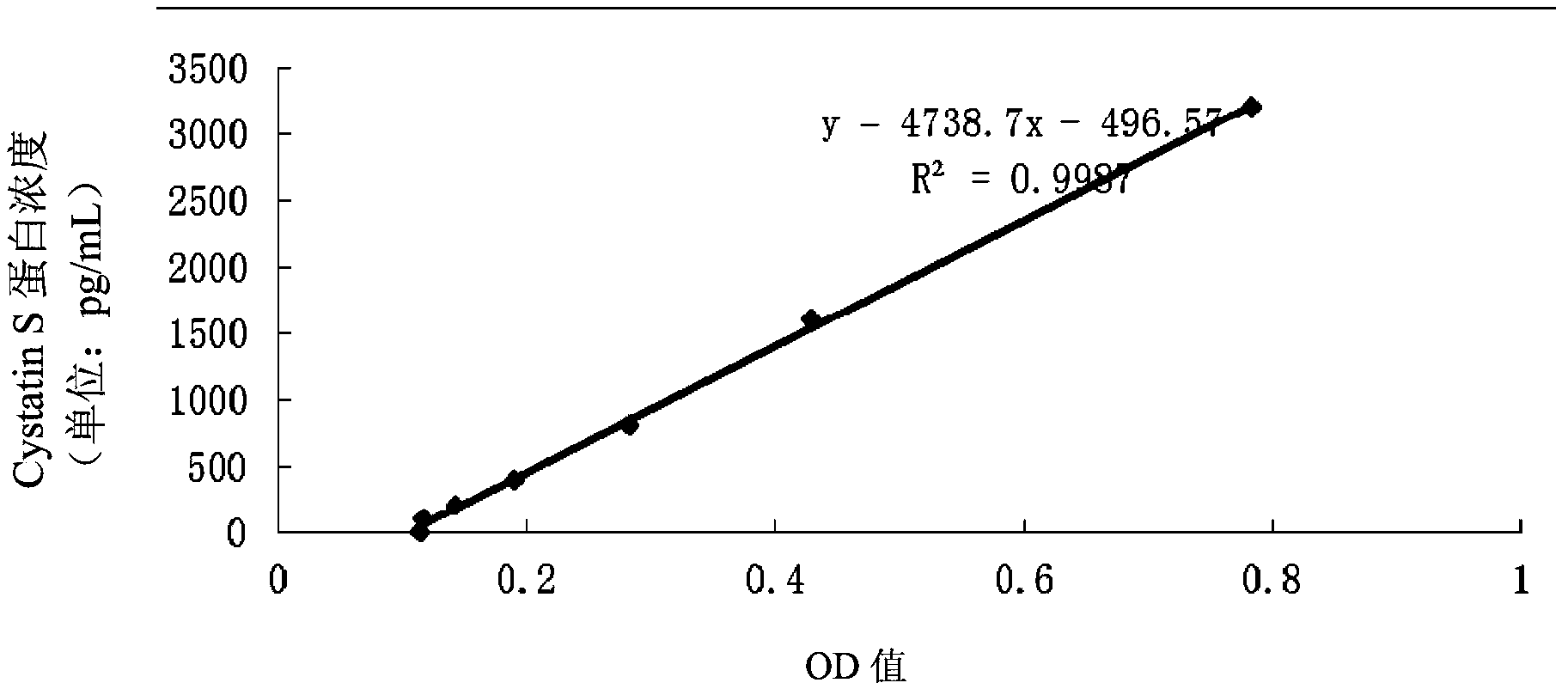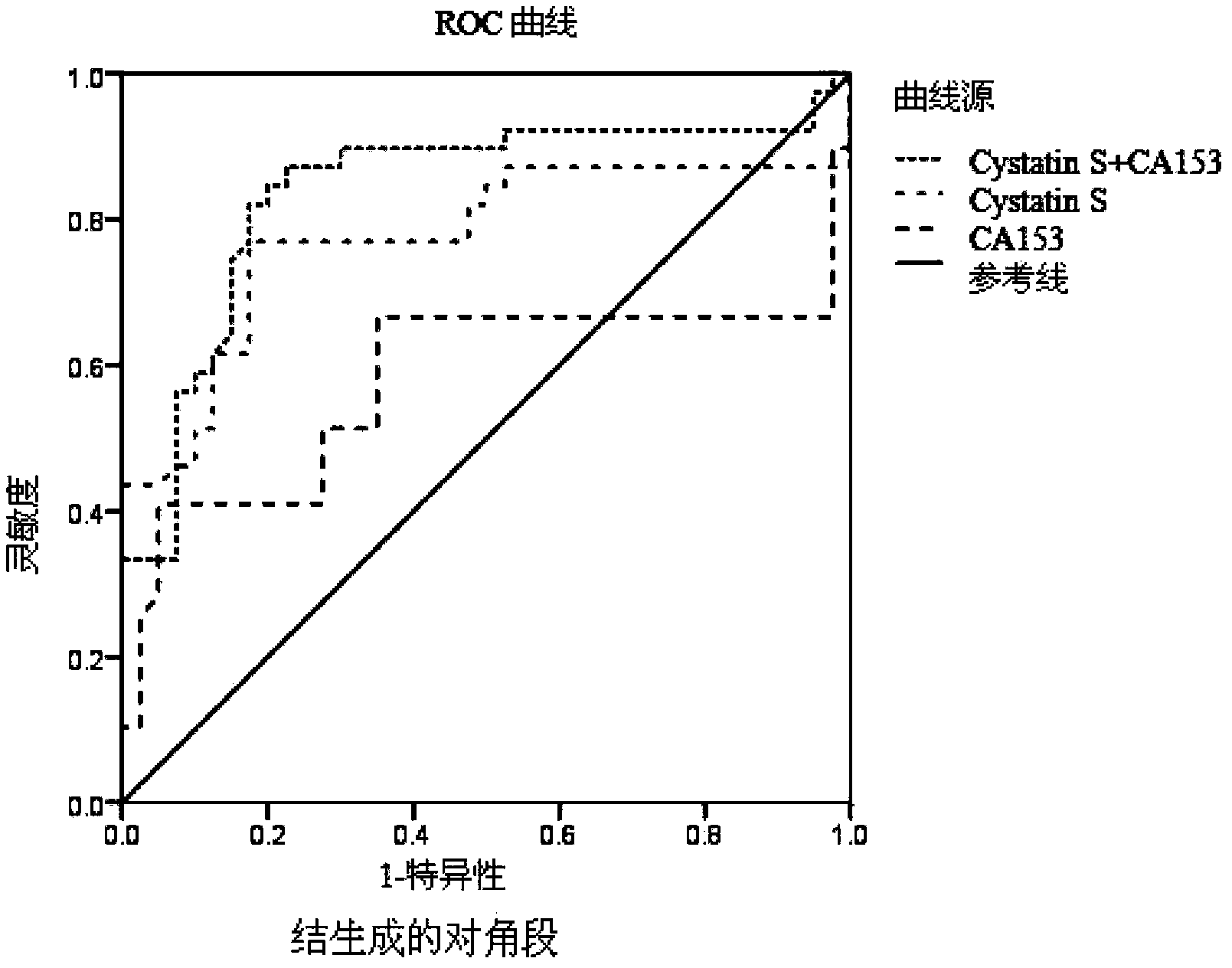Application of Cystatin S and CA15-3 in preparation of markers for diagnosing and predicting breast cancer
A marker and breast cancer technology, which is applied in the field of medical detection, can solve the problems of increasing the complexity of treatment and not being able to diagnose breast cancer, and achieve the effects of improving sensitivity and specificity, being easy to carry, and having good repeatability
- Summary
- Abstract
- Description
- Claims
- Application Information
AI Technical Summary
Problems solved by technology
Method used
Image
Examples
Embodiment 1
[0023] Embodiment 1 establishes Cystatin S serum detection system and its optimization
[0024] Coat the ELISA plate with a mouse anti-human Cystatin S monoclonal antibody at a concentration of 5 μg / mL, and the coating condition is to coat overnight at 4°C, wash the plate; then block in 2% BSA at room temperature for 2 hours , wash the plate; the Cystatin S protein standard substance (the amino acid sequence of encoding Cystatin S such as SEQ ID NO.1) and samples were added to the closed plate, reacted at 37°C for 1 hour, and washed the plate; then reacted with rabbit anti-human Cystatin S polyclonal antibody labeled with HRP at a concentration of 0.5 μg / mL at 37°C for 1 hour , wash the plate; then react with tetramethylbenzidine (TMB) for 2-3 minutes, and finally stop the reaction with 2M sulfuric acid, and detect the OD value under the condition of 450nm ( figure 1 ). The results showed that the linear range of Cystatin S was 50pg / mL-1600pg / mL, the linear correlation coeff...
Embodiment 2
[0031] Embodiment 2 Cystatin S ELISA kit
[0032] According to the establishment of the Cystatin S serum detection reaction system in Example 3, the Cystatin S enzyme-linked immunoassay kit was constructed, and the specific components are as shown in Table 1:
[0033] Table 1. Cystatin S ELISA kit components
[0034]
[0035]
[0036] Evaluate the Cystatin S ELISA kit: use the Cystatin S ELISA kit to detect the Cystatin S positive quality control product, repeat the detection 10 times at two levels of Cystatin S protein concentration of 160pg / mL and 80pg / mL, and the test results show Coefficient of variation CV ≤ 10%; use 3 batches of kits to detect the same sample, and the coefficient of variation between batches of 3 batches of kits CV ≤ 15%. The research on the stability of the kit shows that it can be kept stable after being stored at 4°C for 8 months, stored at 4°C for 2 months after opening, and transported at 0-4°C for 7 days.
Embodiment 3CA153
[0037] Embodiment 3CA153 ELISA kit
[0038] CA153 enzyme-linked immunoassay kit was purchased from Beijing Rejing Biotechnology Co., Ltd. The amino acid sequence of the detected CA153 marker is shown in SEQ ID NO.2.
[0039] Combine the kit purchased in this example with the Cystatin S enzyme-linked immunoassay kit constructed in Example 2 to form a Cystatin S-CA153 combined detection kit, which is used for the diagnosis and prognostic detection of breast cancer.
PUM
| Property | Measurement | Unit |
|---|---|---|
| Sensitivity | aaaaa | aaaaa |
| recovery rate | aaaaa | aaaaa |
| Sensitivity | aaaaa | aaaaa |
Abstract
Description
Claims
Application Information
 Login to View More
Login to View More - Generate Ideas
- Intellectual Property
- Life Sciences
- Materials
- Tech Scout
- Unparalleled Data Quality
- Higher Quality Content
- 60% Fewer Hallucinations
Browse by: Latest US Patents, China's latest patents, Technical Efficacy Thesaurus, Application Domain, Technology Topic, Popular Technical Reports.
© 2025 PatSnap. All rights reserved.Legal|Privacy policy|Modern Slavery Act Transparency Statement|Sitemap|About US| Contact US: help@patsnap.com



